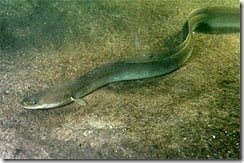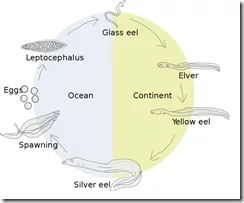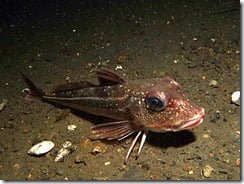 The European eel is an amazing creature. Found in the rivers of the North Atlantic, Baltic and Mediterranean Seas, it has a fascinating life-cycle that involves an incredible two-way migration across the Atlantic ocean.
The European eel is an amazing creature. Found in the rivers of the North Atlantic, Baltic and Mediterranean Seas, it has a fascinating life-cycle that involves an incredible two-way migration across the Atlantic ocean.
Eel eggs hatch in the depths of the Sargasso Sea in the western Atlantic. Tiny, transparent, leaf-like larvae called leptocephali float up to the surface layers of the ocean and begin their long voyage towards Europe drifting with the Gulf Stream. Their long journey across the Atlantic normally takes from seven to eleven months to complete, but the larval stage can last up to three years. Many leptocephali will not survive their oceanic voyage, falling prey to all sorts of predators along the way, but those that do make it will metamorphose into small, transparent eels called glass eels – the next stage in their elaborate life cycle.
Glass eels enter the brackish water of our estuaries and continue their development. When they reach about 50mm (c. 2 inches) long they lose their transparency and start to become darker. Now known as elvers, they feed on small aquatic invertebrates, and begin moving upstream into freshwater, sometimes congregating in large schools as they do so. Eels are independent and solitary during all life-stages, and this aggregation of small eels is thought to be triggered by mass response to favourable environmental conditions rather than any active schooling instinct.
 As elvers grow they metamorphose again, turning into juvenile eels – or yellow eels – ranging in colour from brown to black to olive green with a yellowish underside. Males typically spend from 6-12 years in this stage of their life-cycle, while females typically spend 9-20 years feeding and growing in our rivers before finally reaching sexual maturity.
As elvers grow they metamorphose again, turning into juvenile eels – or yellow eels – ranging in colour from brown to black to olive green with a yellowish underside. Males typically spend from 6-12 years in this stage of their life-cycle, while females typically spend 9-20 years feeding and growing in our rivers before finally reaching sexual maturity.
Eels feed on a wide variety of prey, and will eat almost anything smaller than they are, as well as carrion if they come across it. Females generally grow to be substantially larger than males, reaching lengths of a metre (3.25 ft) or more and with a maximum recorded weight of 6.6 kg (14.5 lb). Eels can survive out of water for lengthy periods on damp nights, and during these nocturnal forays they supplement their diet with terrestrial invertebrates like earthworms, slugs and snails. Eels have been recorded travelling considerable distances over land, and can move between unconnected bodies of freshwater in this way.
When European eels reach sexual maturity they undergo their final metamorphosis. Their eyes become enlarged, and they take on a silvery colour. They cease feeding, and migrate downstream back into the ocean.
They cross the Atlantic again, actively swimming with the ocean currents. They reach the Sargasso Sea between winter and early spring, and there they spawn. Very little is known about the actual spawning process, although it is likely to mirror that of other closely related eel species. Males release their sperm directly into the water where each females has already laid from 2,000,000 to 10,000,000 eggs. The adults die soon after spawning, leaving their fertilised eggs to begin the whole cycle again.
Most eels spawn (and therefore die) at between 7 and 30 years of age, but some live much longer. The oldest recorded European eel was an astonishing 85 years old. Many eels will never make it back to their spawning grounds, falling prey to a host of aquatic and terrestrial predators along the way. They are also a popular human food source, particularly in parts of Europe and Asia.
European eel populations have crashed since the 1970s with a reported decline of 90% or more in the number of eels returning to freshwater habitats across Europe. In October 2011 the European eel was classified as Critically Endangered on the All-Ireland IUCN Red Data List for Freshwater Fish, Amphibians and Reptiles, making it our most threatened native fish species.










4 comments
Trevor
3 July 18. I saw numerous elvers climbing the edges of a waterfall in Wicklow during this heatwave. They were about 3 to 4 inches long, the as wide as an earth worm, moving between flat and round, black in colour like the rock.
Many thanks for the article.
Noelle
this was very helpful for an english paper!!!
ed
You got the yellow and silver stages mixed up, they change from elver to yellow to silver as in the the picture…
Calvin Jones
Thanks Ed… just checked that there and of course you are right… not sure how that slip-up happened but I’ve modified the article accordingly.
All the best,
Calvin!